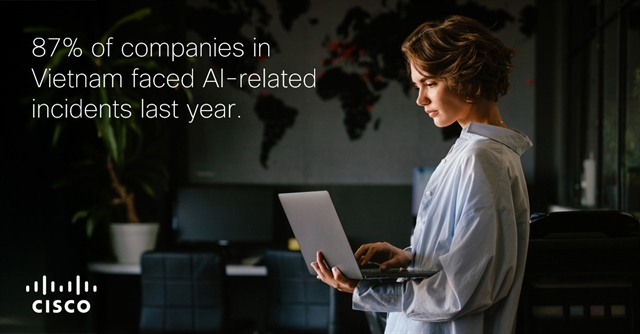Cisco found that AI is not only transforming cybersecurity tools, but also fuelling the threat landscape.

HÀ NỘI — Only 11 per cent of businesses in Việt Nam are deemed ‘Mature’ in their ability to defend against modern cyber threats, according to Cisco’s 2025 Cybersecurity Readiness Index.
While this marks a modest rise from 6 per cent last year, the study highlights a significant gap in preparedness as AI introduces new levels of risk and complexity.
The index, based on a global survey of 8,000 security and business leaders, assessed companies across five key pillars: identity intelligence, network resilience, machine trustworthiness, cloud reinforcement, and AI fortification. Organisations were placed into four stages of readiness: Beginner, Formative, Progressive and Mature.
Cisco found that AI is not only transforming cybersecurity tools but also fuelling the threat landscape. Last year, 87 per cent of organisations experienced AI-related security incidents. Despite this, only 55 per cent of Vietnamese respondents said their employees fully understand AI threats and just 53 per cent believe their security teams grasp how malicious actors are using AI for attacks.
“This year’s report continues to reveal alarming gaps in security readiness and a lack of urgency to address them,” said Jeetu Patel, Cisco’s Chief Product Officer.
“Organisations must rethink their strategies now or risk becoming irrelevant in the AI era.”
In Việt Nam, 78 per cent of businesses anticipate cyber incidents will disrupt operations within the next one to two years. Yet, only 52 per cent allocate more than 10 per cent of their IT budget to cybersecurity — a slight decrease from last year.
AI is being increasingly used as a defence tool, with 96 per cent of Vietnamese organisations saying they use AI for threat detection, understanding and response. However, gaps remain in how these technologies are deployed and managed.
For instance, 25 per cent of employees have unrestricted access to public generative AI tools, while 40 per cent of IT teams are unaware of such usage. Additionally, 62 per cent lack confidence in detecting unregulated or 'shadow AI' deployments.
The shift to hybrid work has added further challenges. Some 90 per cent of organisations reported increased risks from employees using unmanaged devices, while 84 per cent said fragmented security systems— with more than 10 point solutions — are slowing their response to threats.
Compounding these issues is a severe talent shortage. A staggering 95 per cent of firms identified it as a major hurdle, with 42 per cent reporting more than ten cybersecurity positions unfilled.
“To deal with these evolving threats, companies must simplify their security infrastructure and invest in scalable, AI-powered solutions,” said Dzung Nguyen Nhu, Cisco’s Country Leader for Việt Nam, Cambodia and Laos.
“We need a new approach — one that secures AI itself, while leveraging its power to defend.” — VNS





